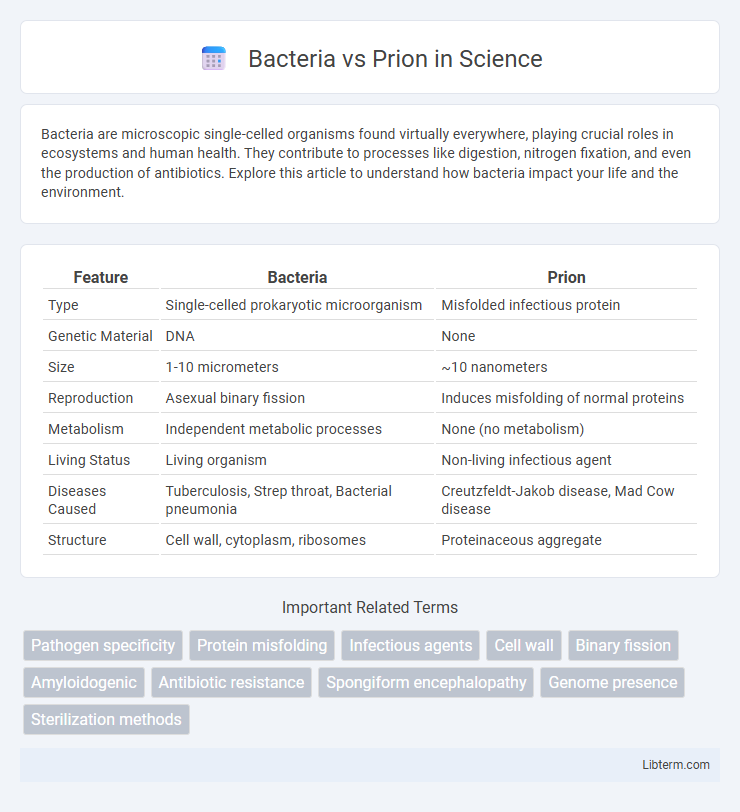Bacteria are microscopic single-celled organisms found virtually everywhere, playing crucial roles in ecosystems and human health. They contribute to processes like digestion, nitrogen fixation, and even the production of antibiotics. Explore this article to understand how bacteria impact your life and the environment.
Table of Comparison
| Feature | Bacteria | Prion |
|---|---|---|
| Type | Single-celled prokaryotic microorganism | Misfolded infectious protein |
| Genetic Material | DNA | None |
| Size | 1-10 micrometers | ~10 nanometers |
| Reproduction | Asexual binary fission | Induces misfolding of normal proteins |
| Metabolism | Independent metabolic processes | None (no metabolism) |
| Living Status | Living organism | Non-living infectious agent |
| Diseases Caused | Tuberculosis, Strep throat, Bacterial pneumonia | Creutzfeldt-Jakob disease, Mad Cow disease |
| Structure | Cell wall, cytoplasm, ribosomes | Proteinaceous aggregate |
Introduction to Bacteria and Prions
Bacteria are single-celled microorganisms with a complex cellular structure, including a cell wall and genetic material organized within a nucleoid, capable of independent reproduction and metabolism. Prions, in contrast, are infectious proteins lacking nucleic acids that cause neurodegenerative diseases by inducing abnormal folding of normal proteins in the brain. Understanding the fundamental differences in structure and replication mechanisms between bacteria and prions is essential for studying infectious disease pathology and developing targeted treatments.
Definitions: What Are Bacteria?
Bacteria are single-celled microorganisms characterized by a simple cell structure without a nucleus, classified under prokaryotes. These organisms can thrive in diverse environments, ranging from soil and water to the human body, playing crucial roles in processes such as decomposition, nitrogen fixation, and human gut health. Unlike prions, which are misfolded proteins causing neurodegenerative diseases, bacteria possess DNA and reproduce through binary fission.
Definitions: What Are Prions?
Prions are infectious agents composed solely of misfolded proteins that cause neurodegenerative diseases by inducing abnormal protein folding in the brain. Unlike bacteria, which are living single-celled organisms capable of reproduction and metabolism, prions lack nucleic acids and cannot replicate independently. Prion diseases, such as Creutzfeldt-Jakob disease, result from the accumulation of these pathogenic proteins, leading to severe neurological damage.
Structural Differences: Bacteria vs Prion
Bacteria are complex, single-celled organisms with a defined cellular structure including a cell wall, plasma membrane, cytoplasm, and genetic material organized within a nucleoid. Prions, in contrast, are infectious proteins devoid of nucleic acids or cellular components, characterized by their abnormal folding of the prion protein (PrP). The structural disparity lies in bacteria being living entities with complete cellular machinery, whereas prions are misfolded proteins causing disease through protein conformational changes.
Methods of Reproduction and Transmission
Bacteria reproduce primarily through binary fission, a rapid asexual process allowing exponential population growth, and can transmit via direct contact, airborne droplets, or contaminated surfaces. Prions, misfolded proteins devoid of nucleic acids, do not reproduce in a traditional sense but propagate by inducing conformational changes in normal host proteins, leading to neurodegenerative diseases. Transmission of prions occurs mainly through contaminated tissue consumption, medical procedures, or inherited mutations, making them uniquely resistant to standard sterilization methods.
Diseases Caused by Bacteria
Bacteria are responsible for a wide range of diseases, including tuberculosis, strep throat, urinary tract infections, and bacterial pneumonia, all caused by pathogenic bacterial strains such as Mycobacterium tuberculosis, Streptococcus pyogenes, Escherichia coli, and Streptococcus pneumoniae. Unlike prions, which cause neurodegenerative diseases like Creutzfeldt-Jakob disease, bacterial infections often trigger immune responses and can be treated with antibiotics. The diverse mechanisms of bacterial pathogenicity contribute to their role in infectious diseases worldwide, impacting respiratory, gastrointestinal, and systemic health.
Diseases Caused by Prions
Prions are infectious proteins responsible for a group of rare, fatal neurodegenerative diseases such as Creutzfeldt-Jakob disease, mad cow disease (bovine spongiform encephalopathy), and kuru. Unlike bacteria, prions lack nucleic acids and resist conventional sterilization methods, making prion diseases difficult to diagnose and treat. These diseases cause brain tissue degeneration, leading to rapid cognitive decline, motor dysfunction, and ultimately death.
Diagnosis and Detection Methods
Bacterial infections are primarily diagnosed through culture techniques, Gram staining, and molecular methods such as PCR to identify specific bacterial DNA sequences. Prion diseases require detection methods focused on abnormal prion protein accumulation using techniques like Western blotting, immunohistochemistry, and newer assays such as real-time quaking-induced conversion (RT-QuIC). While bacterial detection relies on culturing viable organisms, prion diagnosis depends on detecting misfolded protein aggregates in nervous tissue or cerebrospinal fluid.
Treatment Options and Challenges
Bacterial infections are commonly treated with antibiotics targeting cell wall synthesis, protein production, or DNA replication, but antibiotic resistance presents a significant challenge in effective treatment. Prion diseases lack a cure or effective treatment options because prions are misfolded proteins without nucleic acids, making them resistant to conventional antimicrobial agents. The unique biology of prions and evolving bacterial resistance necessitate ongoing research into novel therapeutic strategies and diagnostic tools.
Prevention and Control Strategies
Effective prevention and control strategies for bacteria involve consistent hygiene practices, proper sanitation, and the use of antibiotics under medical guidance to combat bacterial infections while minimizing resistance. Prion diseases require stringent measures such as avoiding consumption of contaminated meat, sterilizing medical instruments with specialized protocols, and surveillance to prevent transmission, as prions are resistant to conventional disinfection. Implementing targeted infection control policies and public health education programs significantly reduces the spread of bacterial pathogens and prion-related illnesses.
Bacteria Infographic

 libterm.com
libterm.com